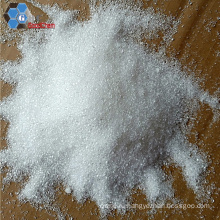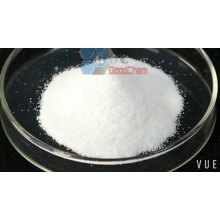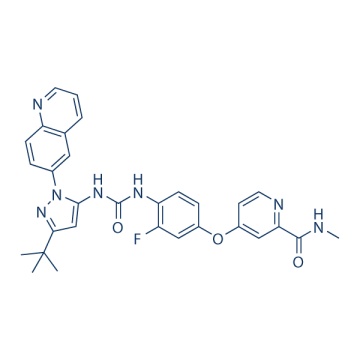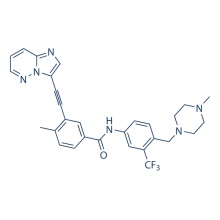.cp_wz table {border-top: твердое тело 1px #ccc; border-left: твердое тело 1px #ccc; } .cp_wz таблица td {border-right: 1px solid #ccc; нижняя граница: сплошной 1px #ccc; padding: 5px 0px 0px 5px;} .cp_wz table th {border-right: 1px solid #ccc; border-bottom: 1px solid #ccc; padding: 5px 0px 0px 5px;} \ n Молекулярный вес: \ n 553,59 DCC-2036 (Ребастиниб) является конформационным контрольным ингибитором Bcr-Abl для Abl1 (WT) и Abl1 (T315I) с IC50 0,8 нМ и 4 нМ, также ингибирует SRC, LYN, FGR, HCK, KDR, FLT3 и Tie-2 и обладает низкой активностью по отношению к c-Kit. Фаза 1. \ n Биологическая активность DCC-2036 демонстрирует сильную ингибирующую активность против очищенного нативного Abl1 в нефосфорилированных (u-Abl1native) и фосфорилированных (p-Abl1native) формах, нефосфорилированных и фосфорилированных мутантах привратника Abl1T315I и мутантной петле активации Abl1H396 Abl1H396. неконкурентоспособный с АТФ способ с IC50 0,8 нМ, 2 нМ, 1,4 нМ, 5 нМ и 4 нМ соответственно. Кроме того, DCC-2036 также ингибирует киназы семейства Src Src, LYN, FGR и HCK и рецепторные TKs KDR, FLT3 и TIE2 с IC50 34 нМ, 29 нМ, 38 нМ, 40 нМ, 4 нМ, 2 нМ. и 6 нМ соответственно. DCC-2036 проявляет антипролиферативную активность против клеток Ba / F3, экспрессирующих нативный или мутантный Bcr-Abl1 с IC50 в диапазоне от 2 до 150 нМ. Кроме того, DCC-2036 также ингибирует пролиферацию линии клеток Ph + K562 (IC50 5,5 нМ) и сильно индуцирует апоптоз как в Bcr-Abl1-экспрессирующих клетках Ba / F3, так и в клетках K562. Недавнее исследование показывает, что DCC-2036 демонстрирует селективность ингибирования роста Bcr-Abl-положительных клеток за счет заметного ингибирования клеточных линий CML по сравнению с линиями лейкемии без CML. В модели аллотрансплантата мыши, несущей лейкозные клетки Ba / F3-Bcr-Abl1T315I, обработка DCC-2036 пероральным зондом в дозе 100 мг / кг один раз в день эффективно ингибирует передачу сигналов Bcr-Abl1 и значительно увеличивает выживаемость мышей. Протокол (только для справки) Анализ киназы: [1]
|
Assay of Abl1 kinase isoforms and determination of inhibitor potency
|
Activity of u-Abl1native is determined by following the production of ADP from the kinase reaction through coupling with the pyruvate kinase/lactate dehydrogenase system. In this assay, the oxidation of NADH (measured as a decreased A340nm) is continuously monitored spectrophotometrically. The final reaction mixture (100 μL, in a 384-well Corning plate) is prepared as follows: An Abl1 kinase/coupled assay components mixture is prepared containing u-Abl1 kinase (1 nM), Abltide (EAIYAAPFAKKK, 0.2 mM), MgCl2 (9 mM), pyruvate kinase (~ 4 units), lactate dehydrogenase (~ 0.7 units), phosphoenol pyruvate (1 mM), and NADH (0.28 mM) in 90 mM Tris containing 0.1 % octyl-glucoside and 1 % DMSO, pH 7.5. Separately, an inhibitor mixture is prepared containing DCC-2036 serially diluted 3-fold in DMSO followed by dilution into buffer composed of 180 mM Tris, pH 7.5, containing MgCl2 (18 mM) and 0.2 % octyl-glucoside. Fifty μL of the inhibitor mixture is mixed with 50 μL of the above Abl1 kinase/coupled assay components mixture, which is then incubated at 30 °C for 2 hours before 2 μL of 25 mM ATP (500 μM, final) is added to start the reaction. The reaction is recorded every 2 minutes for 2.5 hours at 30 °C on a Polarstar Optima or Synergy2 plate reader. Reaction rate (slope) is calculated using the 1 to 2 hour time frame with reader's software. Percent inhibition is obtained by comparison of reaction rate with that of a DMSO control. IC50 values are calculated from a series of percent inhibition values determined at a range of inhibitor concentrations using GraphPad Prism. The kinase assay for Abl1T315I, p-Abl1native or Abl1H396P is assayed the same as above except that 2.2 nM Abl1T315I, 1 nM p-Abl1 native or 1.3 nM Abl1H396P is used. The above assay format is also used for kinases other than Abl1 with the exception of TIE2, for which a fluorescence polarization/Transcreener format is used. The assay conditions are the same as described above except that PolyE4Y (final 1 mg/mL) is used as the substrate and one hour preincubation is used.
|
Клеточный анализ: [1]
|
Cell lines
|
Ba/F3 cells and primary Ph+ leukemia cells
|
|
Concentrations
|
0-10 μM
|
|
Incubation Time
|
72 hours
|
|
Method
|
Ba/F3 cells or primary Ph+ leukemia cells are plated in triplicate in 96-well plates containing test compounds. After 72 hours, viable cells are quantified by Resazurin or MTT assay. Cells are diluted in medium to be added to each well of a 96-well tissue culture-treated plate. All cells are incubated overnight and maintained in a humidified atmosphere at 37 °C and 5% CO2. Cells are treated the following day. Serum-free medium is used during treatment with DCC-2036. MTT is used to assess the viability of cells following treatment. Aliquots of 20 mL of stock MTT solution are added to each well containing 200 mL of medium (10% final solution) and incubated with the cells for 2 hours. Following incubation the medium is removed and 200 mL of dimethylsulfoxide added to solubilize the formazan crystals. The absorbance is read on the plate reader at 550 and 690 nm. A subtraction analysis of the dual wavelength is performed (D550 to D690) to increase accuracy of the measuremen
|
Исследование на животных: [1]
|
Animal Models
|
Ba/F3 cells transformed to interleukin-3 independence by transduction with either Bcr-Abl1native or Bcr-Abl1T315I retrovirus are injected intravenously into syngeneic Balb/c mice.
|
|
Formulation
|
DCC-2036 is dissolved in 0.5% CMC/1% Tween-80.
|
|
Dosages
|
≤100 mg/kg
|
|
Administration
|
Administered via p.o.
|
|
Solubility
|
0.5% CMC/0.25% Tween 80,
16 mg/mL
|
|
* Please note that Selleck tests the solubility of all compounds in-house, and the actual solubility may differ slightly from published values. This is normal and is due to slight batch-to-batch variations.
|
Конверсия различных модельных животных на основе BSA (значение на основе данных из проекта рекомендаций FDA)
|
Species
|
Baboon
|
Dog
|
Monkey
|
Rabbit
|
Guinea pig
|
Rat
|
Hamster
|
Mouse
|
|
Weight (kg)
|
12
|
10
|
3
|
1.8
|
0.4
|
0.15
|
0.08
|
0.02
|
|
Body Surface Area (m2)
|
0.6
|
0.5
|
0.24
|
0.15
|
0.05
|
0.025
|
0.02
|
0.007
|
|
Km factor
|
20
|
20
|
12
|
12
|
8
|
6
|
5
|
3
|
|
Animal A (mg/kg) = Animal B (mg/kg) multiplied by
|
Animal B Km
|
|
Animal A Km
|
Например, чтобы изменить дозу ресвератрола, используемую для мыши (22,4 мг / кг), на дозу, основанную на BSA для крысы, умножьте 22,4 мг / кг на коэффициент Km для мыши, а затем разделите на коэффициент Km для крыса. Этот расчет дает эквивалентную дозу ресвератрола для крыс 11,2 мг / кг.
|
Rat dose (mg/kg) = mouse dose (22.4 mg/kg) ×
|
mouse Km(3)
|
= 11.2 mg/kg
|
|
rat Km(6)
|
Химическая информация
|
Molecular Weight (MW)
|
553.59
|
|
Formula
|
C30H28FN7O3
|
|
CAS No.
|
1020172-07-9
|
|
Storage
|
3 years -20℃Powder
|
|
6 months-80℃in solvent (DMSO, water, etc.)
|
|
Synonyms
|
|
|
Solubility (25°C) *
|
In vitro
|
DMSO
|
111 mg/mL
(200.5 mM)
|
|
Water
|
<1 mg/mL
(
|
|
Ethanol
|
16 mg/mL
(28.9 mM)
|
|
In vivo
|
0.5% CMC/0.25% Tween 80
|
16 mg/mL
|
* <1 mg/ml means slightly soluble or insoluble.
* Please note that Selleck tests the solubility of all compounds in-house, and the actual solubility may differ slightly from published values. This is normal and is due to slight batch-to-batch variations.
|
|
Chemical Name
|
1-(3-tert-butyl-1-(quinolin-6-yl)-1H-pyrazol-5-yl)-3-(2-fluoro-4-(2-(methylcarbamoyl)pyridin-4-yloxy)phenyl)urea
|
Калькулятор молярности Калькулятор разведения Калькулятор молекулярной массы
Группа Продуктов : Ангиогенез > Bcr-Abl ингибитор







